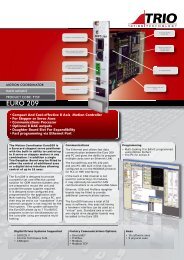AC SERVO SYSTEM - SmartDrive
AC SERVO SYSTEM - SmartDrive
AC SERVO SYSTEM - SmartDrive
You also want an ePaper? Increase the reach of your titles
YUMPU automatically turns print PDFs into web optimized ePapers that Google loves.
Servo Drive Specification<br />
CSDP Plus Series<br />
Classification<br />
Basic SPEC<br />
Speed torque<br />
control<br />
performance ※3<br />
Position control<br />
performance<br />
Input signal for<br />
position control<br />
commands<br />
Input signal for<br />
speed, torque<br />
commands<br />
Multi stage speed<br />
command input<br />
signal<br />
I/O signal<br />
Cautions<br />
10 I Servo Drive Specification<br />
Item<br />
Power Supply ※1<br />
Control Method<br />
Feedback Method ※2<br />
Ambient temperature/humidity for use<br />
Ambient temperature/humidity for storage<br />
Mounting type<br />
Speed control range<br />
Rate of load change<br />
Rate of voltage change<br />
Rate of temperature change<br />
Speed response frequency<br />
Degree of torque control<br />
Acceleration/deceleration Time<br />
Feed forward<br />
Width of position determination<br />
Types of command pulses<br />
Types of input commands<br />
Pulse frequency<br />
Control signal<br />
Command voltage<br />
Input impedance<br />
Circuit constant<br />
Rotation direction<br />
Speed selection<br />
Position output pattern<br />
Input<br />
Output<br />
Dynamic brake<br />
Regenerative resistance ※4<br />
Protection function<br />
Monitoring<br />
SPECIFICATION<br />
Input voltage(Vrms) Triple phase 200~230V, +10~-15%, 50/60Hz<br />
Control voltage(Vrms) Single phase 200~230V, +10~ -15%, 50/60Hz<br />
PWM control using IPM<br />
1000 / 2048 / 2500 / 6000 / 10000 Inc Type, 17 bit Serial Inc/Abs type<br />
0 ~ 55℃ / 90% RH or below<br />
-25 ~ 80℃ / 90% RH or below<br />
Base mounted type<br />
1:5000<br />
Less than ±0.01% at the rated speed and load of 0 to 100%<br />
0% at the rated speed and voltage of 220V<strong>AC</strong><br />
Less than 0.1% at the rated temperature and ambient temperature of 25℃<br />
400 Hz<br />
± 2%<br />
0 - 60sec<br />
0 - 100%<br />
0 - 250 pulse<br />
CW+CCW, pulse row + sign row, Phase A+ phase B(phase difference of 90°)<br />
Line Drive: Level to level voltage 2.8 ~ 3.7V<br />
Open collector: External voltage 24V, 12V, 5V<br />
Line Drive: Max 900kbpps<br />
Open collector: Max 250kpps<br />
Position error clearance input(set to one of input terminals)<br />
± 10VDC(14 bit A/D conversion)<br />
About 8.3M ohms<br />
35 ㎲ or below<br />
The function should be assigned to the input terminal.<br />
The function should be assigned to the input terminal.<br />
Line drive output: Phase A,B,Z, absolute encoder data<br />
Open collector output: Phase Z<br />
Servo on, alarm reset, gain group shift, forward/reverse torque limit, forward/reverse rotation prevention, P/PI control shift, control mode<br />
shift, multi stage speed command, zero clamp, position command pulse ignored, absolute encoder data transmission<br />
Position determination complete, position proximity, in-speed, rotation detection, torque limit detection, speed limit detection, brake control output, servo alarm detection<br />
When the servo power is off, the alarm is on, or overtravel occurs(depending on the condition)<br />
Included in the drive<br />
Overcurrent, overvoltage, overload, over speed, low voltage, CPU malfunction, communication failure<br />
Two channel D/A output for measuring errors in position/speed/torque command as well as feedback and position<br />
※1) Our servo motor includes a built-in DC power supply inside the amp(300V) and it does not require an additional DC power supply. (But it requires a separate DC 24V<br />
power supply to the external I/O.)<br />
※2) It is not possible to generate a number of pulses exceeding the number of encoder pulse per each rotation of the motor.<br />
※3) As the motor decelerates, regenerative energy is created. The regenerative energy that can be absorbed by the drive and the motor depends on the speed of<br />
motor’s rotation and the load inertia.<br />
※4) In case of speed control, it is possible to rotate in one direction due to the offset at the minimum speed.



